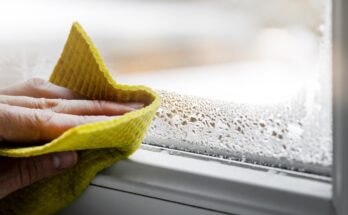We think of spring as “allergy season.” But for lots of people, the allergies come a season early—or they’re even there year-round. While pollen isn’t flying through the air in winter, the season does present its own set of allergy challenges; at this time of year, the irritants are coming from inside the house. Don’t let yourself get cooped up with mold, dust mites, or anything else that could trigger pesky sniffles and wheezing; discover some easy ways to keep these allergens at bay. By learning how to cope with winter allergies, you could make this the winter you finally breathe easily.
Manage Humidity
Setting the proper humidity level in your home during the winter can be a real Goldilocks dilemma. If the humidity is too high, your home becomes a breeding ground for mold, the sworn nemesis of any respiratory system. But if the air gets too dry, you can face dry sinuses, cracked lips, and worst of all, nosebleeds. You need a humidity level that’s just right. Keep your humidity level between 40 and 50 percent, using a hygrometer to measure if necessary. Run fans during showers to keep humidity from skyrocketing in your bathroom and encouraging mold growth.
Clean Green
This winter could be when you discover that what had been bothering you all this time wasn’t just mold or pollen—it was the chemicals in your household cleaning supplies, or the dust flying out from your old vacuum. Take the initiative to lay out an allergy-friendly cleaning plan that minimizes irritating chemicals and sucks up more dust, and see whether it pays off. The results of throwing away those harmful aerosol sprays and going greener may well be a pleasant surprise for you and your allergies.
Expose Your Hardwood
If you still have wall-to-wall carpeting, you could be incubating scores of spores and handfuls of dander in your carpet. Consider switching to hardwood or laminate floors. Of course, renovation work like this is no quick fix, but if you’re planning to be in your home for a long time, this is a necessary improvement to not only your home’s value but to your quality of life.
Wash Bedding Regularly
A big part of going green is to wash your laundry on cold-water cycles. But when it comes to your bedding, you can—and should—allow yourself some hot water to kill off the dust mites that can take hold in your pillowcases and sheets. Once a week, wash your bedding in hot water to keep your sheets as free of allergens as you can get them. If you’re worried that this will prematurely wear out your bedding, consider buying a second set and rotating—your priority should be mitigating mites.
See an Allergist
Still not sure what sets your allergies off? Consult an allergist who can perform extensive diagnostic tests to identify and specify what irritates your body most. This involves injecting numerous common allergens in tiny doses and seeing what your body reacts to. By putting names to your body’s weaknesses, you can determine once and for all how to cope with winter allergies.
FAQ
How should I set the humidity in my house?
Setting the proper humidity level in your home during the winter can be a real Goldilocks dilemma. If the humidity is too high, your home becomes a breeding ground for mold, the sworn nemesis of any respiratory system. But if the air gets too dry, you can face dry sinuses, cracked lips, and worst of all, nosebleeds. You need a humidity level that’s just right. Keep your humidity level between 40 and 50 percent, using a hygrometer to measure if necessary. Run fans during showers to keep humidity from skyrocketing in your bathroom and encouraging mold growth.
Additional Resources:
Bananas



